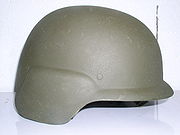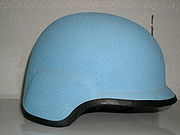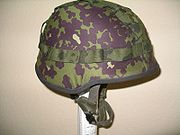
SPECTRA helmet
Encyclopedia

Ultra high molecular weight polyethylene
Ultra-high-molecular-weight polyethylene , also known as high-modulus polyethylene or high-performance polyethylene , is a subset of the thermoplastic polyethylene. It has extremely long chains, with molecular weight numbering in the millions, usually between 2 and 6 million...
fibers, produced under license
License
The verb license or grant licence means to give permission. The noun license or licence refers to that permission as well as to the document recording that permission.A license may be granted by a party to another party as an element of an agreement...
from Honeywell
Honeywell
Honeywell International, Inc. is a major conglomerate company that produces a variety of consumer products, engineering services, and aerospace systems for a wide variety of customers, from private consumers to major corporations and governments....
. The SPECTRA helmet is capable of stopping shell fragment
Fragmentation (weaponry)
Fragmentation is the process by which the casing of an artillery shell, bomb, grenade, etc. is shattered by the detonating high explosive filling. The correct technical terminology for these casing pieces is fragments , although shards or splinters can be used for non-preformed fragments...
s of 1.1 g (0.0388013583156232 oz) travelling at 680 m/s (2,230 ft/s), an 80% improvement over the Modèle 1978 helmet
Modèle 1978 helmet
The Modèle 1978 helmet is a modern military steel helmet used by the French Army under the F1 designation and commonly called "heavy helmet" . It replaced the Modèle 1951 helmet, and is superseded by the SPECTRA helmet.- External links :*...
it replaces.
History

French Army
The French Army, officially the Armée de Terre , is the land-based and largest component of the French Armed Forces.As of 2010, the army employs 123,100 regulars, 18,350 part-time reservists and 7,700 Legionnaires. All soldiers are professionals, following the suspension of conscription, voted in...
of the 2000s. In 1992, the conflict in ex-Yugoslavia put large numbers of French blue helmets in contact with well-trained and well-equipped opponents, especially sniper
Sniper
A sniper is a marksman who shoots targets from concealed positions or distances exceeding the capabilities of regular personnel. Snipers typically have specialized training and distinct high-precision rifles....
s during the Siege of Sarajevo
Siege of Sarajevo
The Siege of Sarajevo is the longest siege of a capital city in the history of modern warfare. Serb forces of the Republika Srpska and the Yugoslav People's Army besieged Sarajevo, the capital city of Bosnia and Herzegovina, from 5 April 1992 to 29 February 1996 during the Bosnian War.After Bosnia...
, where heavier protection than the Modèle 1978 helmet
Modèle 1978 helmet
The Modèle 1978 helmet is a modern military steel helmet used by the French Army under the F1 designation and commonly called "heavy helmet" . It replaced the Modèle 1951 helmet, and is superseded by the SPECTRA helmet.- External links :*...
was proved necessary. The Army requested an emergency study for the new helmet, and tests were made, which selected the Dyneema fiber. Gallet drafted a model based on the PASGT
Personnel Armor System for Ground Troops
Personnel Armor System for Ground Troops, sometimes abbreviated to PASGT, was a combat helmet and ballistic vest used by the American military from the mid 1980s until 2005, when the system was succeeded by the Lightweight Helmet, Modular Integrated Communications Helmet, and Interceptor body...
("Fritz") helmet used by the United States Army
United States Army
The United States Army is the main branch of the United States Armed Forces responsible for land-based military operations. It is the largest and oldest established branch of the U.S. military, and is one of seven U.S. uniformed services...
, and produced a first series of 5,000 which was immediately made available to the Blue Helmets
Peacekeeping
Peacekeeping is an activity that aims to create the conditions for lasting peace. It is distinguished from both peacebuilding and peacemaking....
in the former Yugoslavia. These first models were blue in the mass. Later models used the NATO green colour. They gradually equipped all French troops, with a priority given to the units on missions in foreign territories.
Description
The helmet is made of Spectra fibre. It is not bulletproofBulletproof
Bulletproofing is the process of making something capable of stopping a bullet or similar high velocity projectiles e.g. shrapnel. The term bullet resistance is often preferred because few, if any, practical materials provide complete protection against all types of bullets, or multiple hits in the...
. It is a fragmentation-resistant helmet and has a maximum distortion (loss of shape) of 20 mm from a 9mm FMJ (Full Metal Jacket) bullet of 8 g (124 gr) travelling between 390 and 420 m/s on impact. It has a resistance to fragments in accordance with NATO Standardised Regulation ("STANAG
STANAG
STANAG is the NATO abbreviation for Standardization Agreement, which sets up processes, procedures, terms, and conditions for common military or technical procedures or equipment between the member countries of the alliance. Each NATO state ratifies a STANAG and implements it within their own...
") 2920, V50 mini, which is 640 m/s. Resistance to shock-impact in accordance with the EN397 standard, which is a protection standard for industrial helmets.
The helmet can be worn with earmuffs and an individual radio system. Further equipment, like night vision, can be added; the new infantry combat equipment of the French army, the Félin
Félin
FÉLIN is the name for the French infantry combat system of the 2000s....
system, is partly based on development of the SPECTRA helmet.
Models
Official designation of CGF Gallet is Série 8320 casque de combat TC "D" and they are made in three size;- 008320-VKM
- 008320-VKL
- 008320-VKXL
The "V" is for French "vert" (Green). "M", "L", "XL" is the size.
The helmet is also available without the visor, as to facilitate the use of night vision equipment, and with added protection for law enforcement.
Size
The official designations "M", "L" and "XL" are usually called Small, Medium and Large in Denmark.Head diameter is;
- M: 55.0 – 57.5 cm
- L: 57.5 – 60.5 cm
- XL: 60.5 – 64.0 cm
Danish use
In Denmark it is designated as Helmet, M/96, green.In the early 1990s the Danish army began looking for a replacement to the old US M1 helmet
M1 Helmet
The M1 helmet is a combat helmet that was used by the American military from World War II until it was succeeded by the PASGT helmet beginning in 1985. For over forty years, the M1 was standard issue for the U.S...
designated M/46 Steel helmet, which had been the standard helmet in Denmark since World War 2. The M/96 helmet may be completely phased out very soon in favour of a version of the Gentex ACH
Advanced Combat Helmet
The Advanced Combat Helmet is the United States Army's current combat helmet. It was developed by the United States Army Soldier Systems Center to be the next generation of protective combat helmets for use by the U.S. Army...
.
Helmet covers

- Helmet cover "Dk-version". An early version produced probably locally in Denmark. Almost identical to the CGF Gallet 900076 version but without a rubber rim, instead it has a drawstringDrawstringA drawstring is a string, cord, or rope used to "draw" or tie closed an opening in fabric or other material...
to keep it tight to the helmet. The loops of the drawstrings on top of the helmet sometimes are quite big. M/84 camouflage pattern. Still in use in some places until roughly 1998 or 1999. - M/96 Helmet cover. CGF Gallet 900076-VSxx (x = XL, L, M). This is the standard cover in the Danish army. M/84 camouflage pattern and a big rubber rim to hold it tight to the helmet. Made of the same fabric as the M/84 Combat uniform (67% cotton & 33% polyester).
- M/03 Helmet cover. MSA Gallet 501814-JJxx (x = XL, L, M). With M/99 Desert camouflage pattern and a large rubber rim to hold it tight to the helmet. Made of the same fabric as the M/03 Desert uniform (90% cotton & 10% polyester)
Canadian Variant
The Canadian ForcesCanadian Forces
The Canadian Forces , officially the Canadian Armed Forces , are the unified armed forces of Canada, as constituted by the National Defence Act, which states: "The Canadian Forces are the armed forces of Her Majesty raised by Canada and consist of one Service called the Canadian Armed Forces."...
adopted the SPECTRA with a few modifications. The CG634
CG634
The CG634 are the Canadian Forces' main combat helmet. Introduced in 1997 and based on the French SPECTRA helmet.-History:The Canadian military sought a replacement for the steel M1 Helmet in the 1980s. It trialled the American PASGT and the related French SPECTRA helmets, before deciding to adopt...
Helmet was introduced in 1997 replacing the old M1 Helmet
M1 Helmet
The M1 helmet is a combat helmet that was used by the American military from World War II until it was succeeded by the PASGT helmet beginning in 1985. For over forty years, the M1 was standard issue for the U.S...
. The CF trialled the US Personnel Armor System for Ground Troops
Personnel Armor System for Ground Troops
Personnel Armor System for Ground Troops, sometimes abbreviated to PASGT, was a combat helmet and ballistic vest used by the American military from the mid 1980s until 2005, when the system was succeeded by the Lightweight Helmet, Modular Integrated Communications Helmet, and Interceptor body...
in 1990s before adopting the French version. The Canadian version is made by Barrday of Ontario
Ontario
Ontario is a province of Canada, located in east-central Canada. It is Canada's most populous province and second largest in total area. It is home to the nation's most populous city, Toronto, and the nation's capital, Ottawa....
(trial versions) and GSI (Gallet Sécurité Internationale) in Saint-Romuald, Quebec
Saint-Romuald, Quebec
Saint-Romuald is a district of Lévis, Quebec, Canada, located on the south shore of the Saint Lawrence River across from Quebec City. The district was formerly a town , but was amalgamated with Lévis on January 1, 2002....
.
Users
- modified version with superior ballistic protection known as the CG634CG634
The CG634 are the Canadian Forces' main combat helmet. Introduced in 1997 and based on the French SPECTRA helmet.-History:The Canadian military sought a replacement for the steel M1 Helmet in the 1980s. It trialled the American PASGT and the related French SPECTRA helmets, before deciding to adopt...
- Helmet, M/96, green

